MGT230: Indigenous Australians, Sustainability, and Business Ethics
VerifiedAdded on 2022/11/14
|5
|1354
|488
Homework Assignment
AI Summary
This assignment addresses the complex relationship between Indigenous Australians, their land, and the principles of ethics and sustainability. It begins by describing the profound connection Indigenous Australians have with their land, emphasizing its significance beyond a mere physical element and its integral role in their identity and economic activities. The assignment highlights the importance of environmentally sustainable practices rooted in traditional knowledge and the ongoing efforts to revitalize cultural connections to the land. It then delves into the historical policies and practices, such as dispossession and the Stolen Generations, that marginalized Indigenous Australians, leading to socio-economic disadvantages. The assignment examines the lasting impact of this marginalization on their social and economic standing. Finally, it explores the role of contemporary businesses in corporate social responsibility (CSR), emphasizing the need to respect Indigenous culture, protect natural resources, and engage Indigenous communities in decision-making to ensure sustainable practices and ethical business operations. The assignment underscores the importance of integrating traditional and modern approaches to environmental management and fostering a respectful approach to socio-ecological systems.
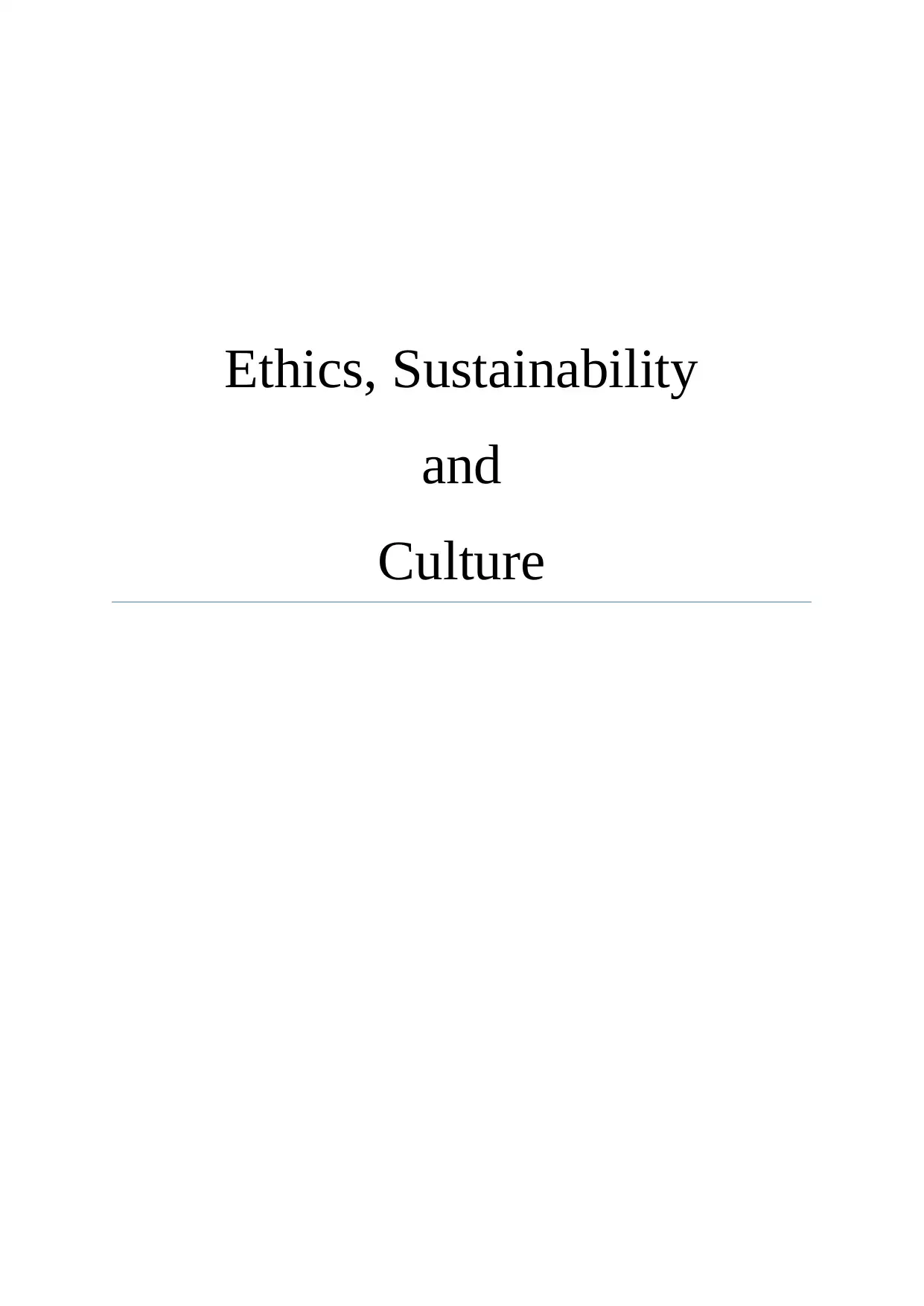
Ethics, Sustainability
and
Culture
and
Culture
Paraphrase This Document
Need a fresh take? Get an instant paraphrase of this document with our AI Paraphraser
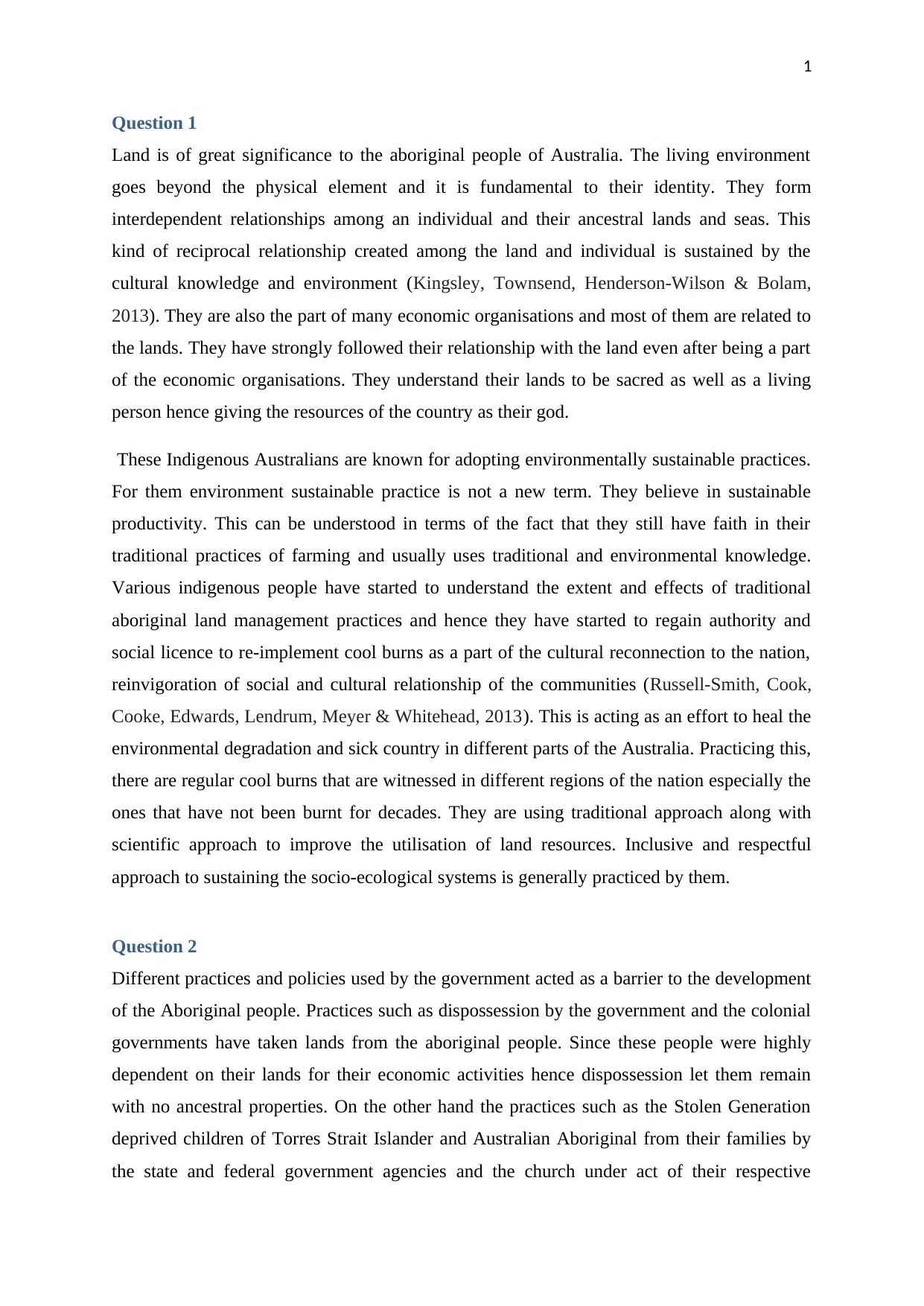
1
Question 1
Land is of great significance to the aboriginal people of Australia. The living environment
goes beyond the physical element and it is fundamental to their identity. They form
interdependent relationships among an individual and their ancestral lands and seas. This
kind of reciprocal relationship created among the land and individual is sustained by the
cultural knowledge and environment (Kingsley, Townsend, Henderson-Wilson & Bolam,
2013). They are also the part of many economic organisations and most of them are related to
the lands. They have strongly followed their relationship with the land even after being a part
of the economic organisations. They understand their lands to be sacred as well as a living
person hence giving the resources of the country as their god.
These Indigenous Australians are known for adopting environmentally sustainable practices.
For them environment sustainable practice is not a new term. They believe in sustainable
productivity. This can be understood in terms of the fact that they still have faith in their
traditional practices of farming and usually uses traditional and environmental knowledge.
Various indigenous people have started to understand the extent and effects of traditional
aboriginal land management practices and hence they have started to regain authority and
social licence to re-implement cool burns as a part of the cultural reconnection to the nation,
reinvigoration of social and cultural relationship of the communities (Russell-Smith, Cook,
Cooke, Edwards, Lendrum, Meyer & Whitehead, 2013). This is acting as an effort to heal the
environmental degradation and sick country in different parts of the Australia. Practicing this,
there are regular cool burns that are witnessed in different regions of the nation especially the
ones that have not been burnt for decades. They are using traditional approach along with
scientific approach to improve the utilisation of land resources. Inclusive and respectful
approach to sustaining the socio-ecological systems is generally practiced by them.
Question 2
Different practices and policies used by the government acted as a barrier to the development
of the Aboriginal people. Practices such as dispossession by the government and the colonial
governments have taken lands from the aboriginal people. Since these people were highly
dependent on their lands for their economic activities hence dispossession let them remain
with no ancestral properties. On the other hand the practices such as the Stolen Generation
deprived children of Torres Strait Islander and Australian Aboriginal from their families by
the state and federal government agencies and the church under act of their respective
Question 1
Land is of great significance to the aboriginal people of Australia. The living environment
goes beyond the physical element and it is fundamental to their identity. They form
interdependent relationships among an individual and their ancestral lands and seas. This
kind of reciprocal relationship created among the land and individual is sustained by the
cultural knowledge and environment (Kingsley, Townsend, Henderson-Wilson & Bolam,
2013). They are also the part of many economic organisations and most of them are related to
the lands. They have strongly followed their relationship with the land even after being a part
of the economic organisations. They understand their lands to be sacred as well as a living
person hence giving the resources of the country as their god.
These Indigenous Australians are known for adopting environmentally sustainable practices.
For them environment sustainable practice is not a new term. They believe in sustainable
productivity. This can be understood in terms of the fact that they still have faith in their
traditional practices of farming and usually uses traditional and environmental knowledge.
Various indigenous people have started to understand the extent and effects of traditional
aboriginal land management practices and hence they have started to regain authority and
social licence to re-implement cool burns as a part of the cultural reconnection to the nation,
reinvigoration of social and cultural relationship of the communities (Russell-Smith, Cook,
Cooke, Edwards, Lendrum, Meyer & Whitehead, 2013). This is acting as an effort to heal the
environmental degradation and sick country in different parts of the Australia. Practicing this,
there are regular cool burns that are witnessed in different regions of the nation especially the
ones that have not been burnt for decades. They are using traditional approach along with
scientific approach to improve the utilisation of land resources. Inclusive and respectful
approach to sustaining the socio-ecological systems is generally practiced by them.
Question 2
Different practices and policies used by the government acted as a barrier to the development
of the Aboriginal people. Practices such as dispossession by the government and the colonial
governments have taken lands from the aboriginal people. Since these people were highly
dependent on their lands for their economic activities hence dispossession let them remain
with no ancestral properties. On the other hand the practices such as the Stolen Generation
deprived children of Torres Strait Islander and Australian Aboriginal from their families by
the state and federal government agencies and the church under act of their respective
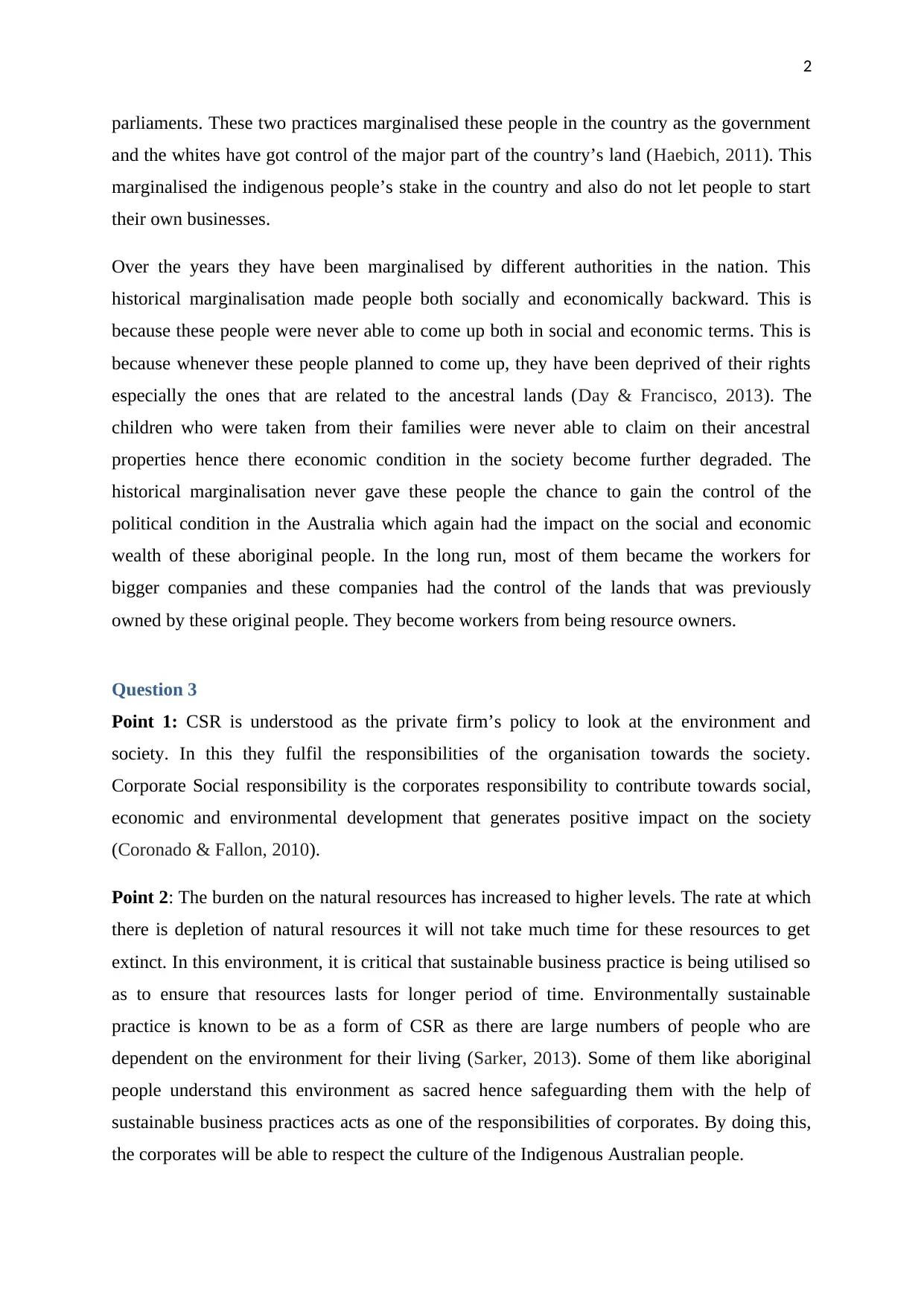
2
parliaments. These two practices marginalised these people in the country as the government
and the whites have got control of the major part of the country’s land (Haebich, 2011). This
marginalised the indigenous people’s stake in the country and also do not let people to start
their own businesses.
Over the years they have been marginalised by different authorities in the nation. This
historical marginalisation made people both socially and economically backward. This is
because these people were never able to come up both in social and economic terms. This is
because whenever these people planned to come up, they have been deprived of their rights
especially the ones that are related to the ancestral lands (Day & Francisco, 2013). The
children who were taken from their families were never able to claim on their ancestral
properties hence there economic condition in the society become further degraded. The
historical marginalisation never gave these people the chance to gain the control of the
political condition in the Australia which again had the impact on the social and economic
wealth of these aboriginal people. In the long run, most of them became the workers for
bigger companies and these companies had the control of the lands that was previously
owned by these original people. They become workers from being resource owners.
Question 3
Point 1: CSR is understood as the private firm’s policy to look at the environment and
society. In this they fulfil the responsibilities of the organisation towards the society.
Corporate Social responsibility is the corporates responsibility to contribute towards social,
economic and environmental development that generates positive impact on the society
(Coronado & Fallon, 2010).
Point 2: The burden on the natural resources has increased to higher levels. The rate at which
there is depletion of natural resources it will not take much time for these resources to get
extinct. In this environment, it is critical that sustainable business practice is being utilised so
as to ensure that resources lasts for longer period of time. Environmentally sustainable
practice is known to be as a form of CSR as there are large numbers of people who are
dependent on the environment for their living (Sarker, 2013). Some of them like aboriginal
people understand this environment as sacred hence safeguarding them with the help of
sustainable business practices acts as one of the responsibilities of corporates. By doing this,
the corporates will be able to respect the culture of the Indigenous Australian people.
parliaments. These two practices marginalised these people in the country as the government
and the whites have got control of the major part of the country’s land (Haebich, 2011). This
marginalised the indigenous people’s stake in the country and also do not let people to start
their own businesses.
Over the years they have been marginalised by different authorities in the nation. This
historical marginalisation made people both socially and economically backward. This is
because these people were never able to come up both in social and economic terms. This is
because whenever these people planned to come up, they have been deprived of their rights
especially the ones that are related to the ancestral lands (Day & Francisco, 2013). The
children who were taken from their families were never able to claim on their ancestral
properties hence there economic condition in the society become further degraded. The
historical marginalisation never gave these people the chance to gain the control of the
political condition in the Australia which again had the impact on the social and economic
wealth of these aboriginal people. In the long run, most of them became the workers for
bigger companies and these companies had the control of the lands that was previously
owned by these original people. They become workers from being resource owners.
Question 3
Point 1: CSR is understood as the private firm’s policy to look at the environment and
society. In this they fulfil the responsibilities of the organisation towards the society.
Corporate Social responsibility is the corporates responsibility to contribute towards social,
economic and environmental development that generates positive impact on the society
(Coronado & Fallon, 2010).
Point 2: The burden on the natural resources has increased to higher levels. The rate at which
there is depletion of natural resources it will not take much time for these resources to get
extinct. In this environment, it is critical that sustainable business practice is being utilised so
as to ensure that resources lasts for longer period of time. Environmentally sustainable
practice is known to be as a form of CSR as there are large numbers of people who are
dependent on the environment for their living (Sarker, 2013). Some of them like aboriginal
people understand this environment as sacred hence safeguarding them with the help of
sustainable business practices acts as one of the responsibilities of corporates. By doing this,
the corporates will be able to respect the culture of the Indigenous Australian people.
⊘ This is a preview!⊘
Do you want full access?
Subscribe today to unlock all pages.

Trusted by 1+ million students worldwide
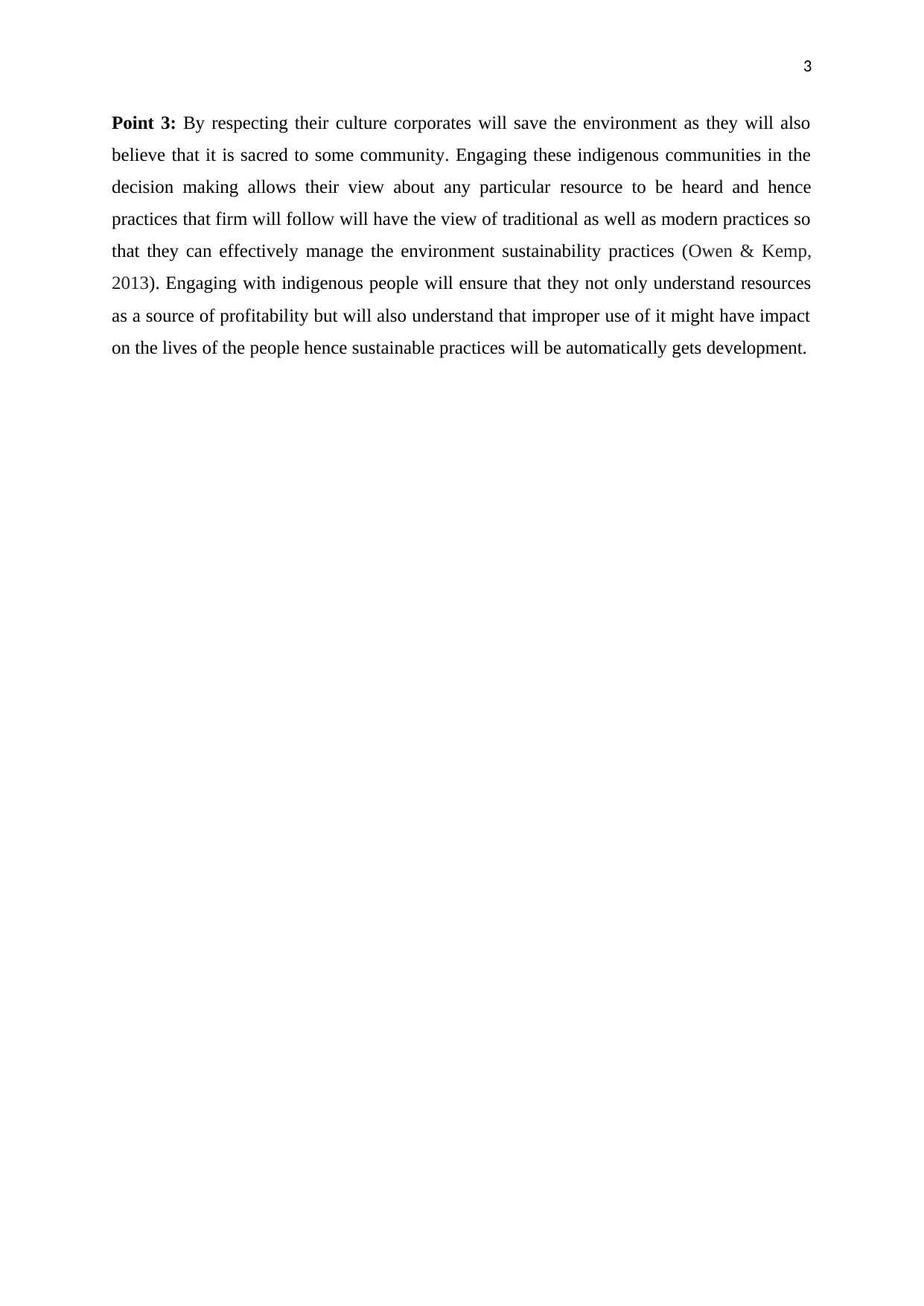
3
Point 3: By respecting their culture corporates will save the environment as they will also
believe that it is sacred to some community. Engaging these indigenous communities in the
decision making allows their view about any particular resource to be heard and hence
practices that firm will follow will have the view of traditional as well as modern practices so
that they can effectively manage the environment sustainability practices (Owen & Kemp,
2013). Engaging with indigenous people will ensure that they not only understand resources
as a source of profitability but will also understand that improper use of it might have impact
on the lives of the people hence sustainable practices will be automatically gets development.
Point 3: By respecting their culture corporates will save the environment as they will also
believe that it is sacred to some community. Engaging these indigenous communities in the
decision making allows their view about any particular resource to be heard and hence
practices that firm will follow will have the view of traditional as well as modern practices so
that they can effectively manage the environment sustainability practices (Owen & Kemp,
2013). Engaging with indigenous people will ensure that they not only understand resources
as a source of profitability but will also understand that improper use of it might have impact
on the lives of the people hence sustainable practices will be automatically gets development.
Paraphrase This Document
Need a fresh take? Get an instant paraphrase of this document with our AI Paraphraser
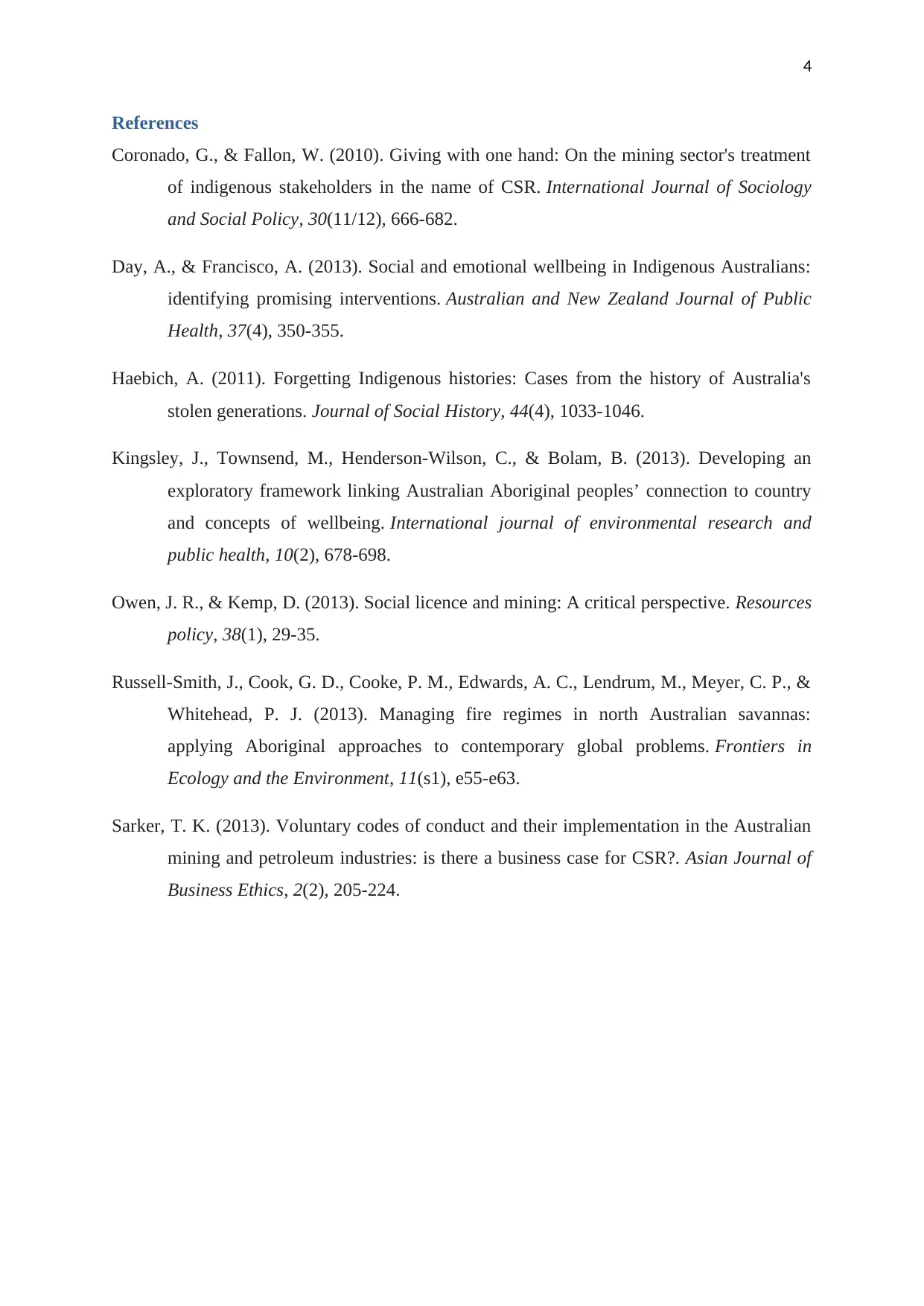
4
References
Coronado, G., & Fallon, W. (2010). Giving with one hand: On the mining sector's treatment
of indigenous stakeholders in the name of CSR. International Journal of Sociology
and Social Policy, 30(11/12), 666-682.
Day, A., & Francisco, A. (2013). Social and emotional wellbeing in Indigenous Australians:
identifying promising interventions. Australian and New Zealand Journal of Public
Health, 37(4), 350-355.
Haebich, A. (2011). Forgetting Indigenous histories: Cases from the history of Australia's
stolen generations. Journal of Social History, 44(4), 1033-1046.
Kingsley, J., Townsend, M., Henderson-Wilson, C., & Bolam, B. (2013). Developing an
exploratory framework linking Australian Aboriginal peoples’ connection to country
and concepts of wellbeing. International journal of environmental research and
public health, 10(2), 678-698.
Owen, J. R., & Kemp, D. (2013). Social licence and mining: A critical perspective. Resources
policy, 38(1), 29-35.
Russell-Smith, J., Cook, G. D., Cooke, P. M., Edwards, A. C., Lendrum, M., Meyer, C. P., &
Whitehead, P. J. (2013). Managing fire regimes in north Australian savannas:
applying Aboriginal approaches to contemporary global problems. Frontiers in
Ecology and the Environment, 11(s1), e55-e63.
Sarker, T. K. (2013). Voluntary codes of conduct and their implementation in the Australian
mining and petroleum industries: is there a business case for CSR?. Asian Journal of
Business Ethics, 2(2), 205-224.
References
Coronado, G., & Fallon, W. (2010). Giving with one hand: On the mining sector's treatment
of indigenous stakeholders in the name of CSR. International Journal of Sociology
and Social Policy, 30(11/12), 666-682.
Day, A., & Francisco, A. (2013). Social and emotional wellbeing in Indigenous Australians:
identifying promising interventions. Australian and New Zealand Journal of Public
Health, 37(4), 350-355.
Haebich, A. (2011). Forgetting Indigenous histories: Cases from the history of Australia's
stolen generations. Journal of Social History, 44(4), 1033-1046.
Kingsley, J., Townsend, M., Henderson-Wilson, C., & Bolam, B. (2013). Developing an
exploratory framework linking Australian Aboriginal peoples’ connection to country
and concepts of wellbeing. International journal of environmental research and
public health, 10(2), 678-698.
Owen, J. R., & Kemp, D. (2013). Social licence and mining: A critical perspective. Resources
policy, 38(1), 29-35.
Russell-Smith, J., Cook, G. D., Cooke, P. M., Edwards, A. C., Lendrum, M., Meyer, C. P., &
Whitehead, P. J. (2013). Managing fire regimes in north Australian savannas:
applying Aboriginal approaches to contemporary global problems. Frontiers in
Ecology and the Environment, 11(s1), e55-e63.
Sarker, T. K. (2013). Voluntary codes of conduct and their implementation in the Australian
mining and petroleum industries: is there a business case for CSR?. Asian Journal of
Business Ethics, 2(2), 205-224.
1 out of 5
Related Documents
Your All-in-One AI-Powered Toolkit for Academic Success.
+13062052269
info@desklib.com
Available 24*7 on WhatsApp / Email
![[object Object]](/_next/static/media/star-bottom.7253800d.svg)
Unlock your academic potential
Copyright © 2020–2025 A2Z Services. All Rights Reserved. Developed and managed by ZUCOL.





